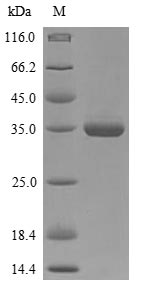Recombinant Bordetella bronchiseptica Azurin (BB3856) is produced using a yeast expression system and contains the complete mature protein spanning amino acids 22 to 150. The protein includes an N-terminal 6xHis-sumostar tag, which aids in purification and detection processes. SDS-PAGE analysis confirms that the product achieves greater than 90% purity. This level of purity appears to support reliable performance in research work, while endotoxin levels remain appropriate for experimental applications.
Azurin from Bordetella bronchiseptica serves an important function in electron transfer processes. This small, blue copper protein participates in various biological oxidation-reduction reactions. Its capacity to mediate electron transfer has drawn attention from researchers studying bacterial respiratory pathways and bioenergetics. The protein's distinctive characteristics continue to make it valuable for biochemical and biophysical investigations.
Potential Applications
Note: The applications listed below are based on what we know about this protein's biological functions, published research, and experience from experts in the field. However, we haven't fully tested all of these applications ourselves yet. We'd recommend running some preliminary tests first to make sure they work for your specific research goals.
Based on the provided information, the recombinant azurin protein is unlikely to be correctly folded or fully bioactive for its native functions. Azurin is a type I copper protein requiring precise coordination of a copper ion within its beta-barrel structure for proper folding and electron transfer function. The N-terminal 6xHis-SUMOstar tag (approximately 15-20 kDa) is substantially larger than the mature azurin domain (∼14 kDa) and may severely interfere with the protein's tertiary structure, particularly near the copper-binding site which is essential for function. While the yeast expression system provides eukaryotic folding machinery, the massive fusion tag likely prevents proper copper incorporation and structural maturation.
This recombinant azurin can generate antibodies, but they will primarily recognize the immunodominant SUMOstar tag rather than azurin-specific epitopes. For antibodies targeting native azurin conformations, the fusion tag must be removed before immunization. The current construct is more suitable for developing anti-SUMOstar tag antibodies. In immunoassays, the signal will predominantly come from tag recognition rather than azurin detection.
Given the substantial interference from the large SUMOstar tag, the primary recommendation is to remove the fusion tag using the SUMO protease recognition site (inherent in SUMOstar systems) and purify the tag-free azurin before any functional studies. The purification strategy should include affinity chromatography using the His-tag (on the SUMOstar portion), SUMO protease cleavage, followed by reverse purification to separate the tag-free azurin from the cleaved tag and protease. After tag removal, the protein should be characterized by UV-visible spectroscopy to confirm copper incorporation (A625 nm), circular dichroism to verify proper beta-barrel folding, and functional assays to validate electron transfer capability. Until tag removal and functional validation are completed, applications should be limited to tag-characterization studies rather than native azurin functions.






